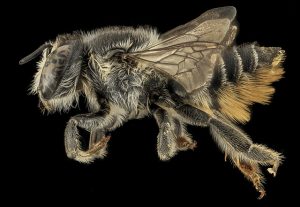It Takes More than Flowers: How Urban Heat Affects Bee Populations

This post was written by Steve Frank, Southeast CSC Principal Investigator and Faculty Affiliate, summarizing work on SE CSC project, Consequences of Urbanization and Climate Change on Human and Ecosystem Health. It is also posted on the EcoIPM website here and summarized on an NCSU News post here.
It takes more than flowers to build bee habitat

If you build it they will come. Local politicians pilfer this line when coaxing constituents to support development projects. Build the waterfront, tourists will come. Build the stadium, jobs will come. Conservation types also administer this line when promoting habitat protections or improvements to help imperiled species. Threadbare as it is, the sentence still generally applies since species cannot exist without habitat except in zoos. Build new habitat, protect or improve old habitat, and your species of interest might arrive.
Pollinator enthusiasts have ardently embraced this idea. There has been an explosion of pollinator conservation activities such as using pollinator friendly plant species and gardening practices, installing pollinator gardens, and providing nesting resources. Again, if you build it – provide the necessary resources – the bees will come and their populations may thrive. This makes sense and is a worthwhile practice just like installing bluebird nest boxes.
But what if you built nest boxes in a wind farm or highway median? The birds would probably come, but obvious hazards may prevent them from thriving. Our research on native pollinators suggests this situation exists for bees in cities. Urban yards can be tough for bees. There are often not enough flowers, or the wrong kinds of flowers, so people compensate with pollinator gardens. However, cities are also hot, due to impervious surfaces and the urban heat island effect.

Wild bees differ in how well they tolerate high temperatures, so heat-sensitive species like Agapostemon virescens and Megachile mendica are less abundant in hot urban sites.

So, can planting flowers compensate for the negative effects of urban heat? We studied wild bees in 18 urban yards and parks throughout Raleigh, NC, that had different temperatures, area of impervious surface cover, and density and diversity of flowers. In a new paper by April Hamblin and Elsa Youngsteadt, we describe how, at the hottest sites, bee abundance declined regardless of flower abundance or diversity.
Although large species of bees (such as bumble bees or sunflower bees) did become more abundant with increasing flower density, small bees (such as sweat bees) suffered the negative effects of warming with no counteracting benefit of flowers. In fact, total bee abundance declined 41% for each degree Celsius of warming. Thus, in a yard with an average temperature of 25°C we collected around 300 bees. In a hotter yard nearby with an average temperature 27°C we collected just 100 bees. In addition, the composition of species was different, with fewer heat-sensitive species at hot sites and more heat-tolerant species.


Wild bee abundance also declined in areas with more impervious surfaces like roads and sidewalks, which are also bad for honey bees. This makes sense because impervious surfaces make the air hotter and because any area covered by concrete is not available for nesting or planting flowers. A double whammy.
The good news? Our research confirms that if you plant flowers – if you build it – bees will come. Bee abundance and diversity increased with flower abundance even though temperature and impervious surface mitigated the number and types of bees. Thus, in addition to planting flowers, try to reduce the amount of heat and impervious surface around your yard or park. Of course you can’t tear up sidewalks and roads (please don’t) but planting trees to shade those surfaces will help cool things down. There’s more to building bee habitat than planting flowers.

Read the full paper:
Hamblin, A.L.†, Youngsteadt, E., Frank, S.D. (2018) Wild bee abundance declines with urban warming, regardless of floral density. Urban Ecosystems, https://doi.org/10.1007/s11252-018-0731-4.
This study was funded in part by an Agriculture and Food Research Initiative Competitive Grant (2013-02476) from the USDA National Institute of Food and Agriculture to S.D. Frank and E. Youngsteadt. This work was also funded by Cooperative Agreement No. G11 AC20471, G13 AC00405, and G15AP00153 from the United States Geological Survey to S.D. Frank.
- Categories:
